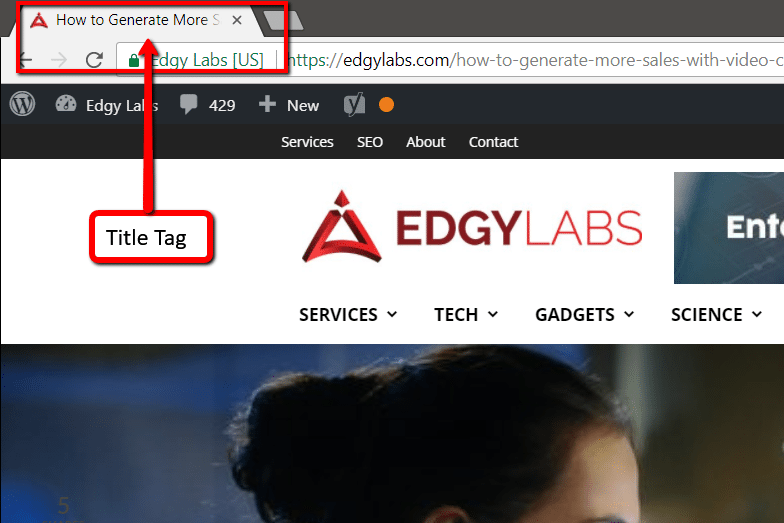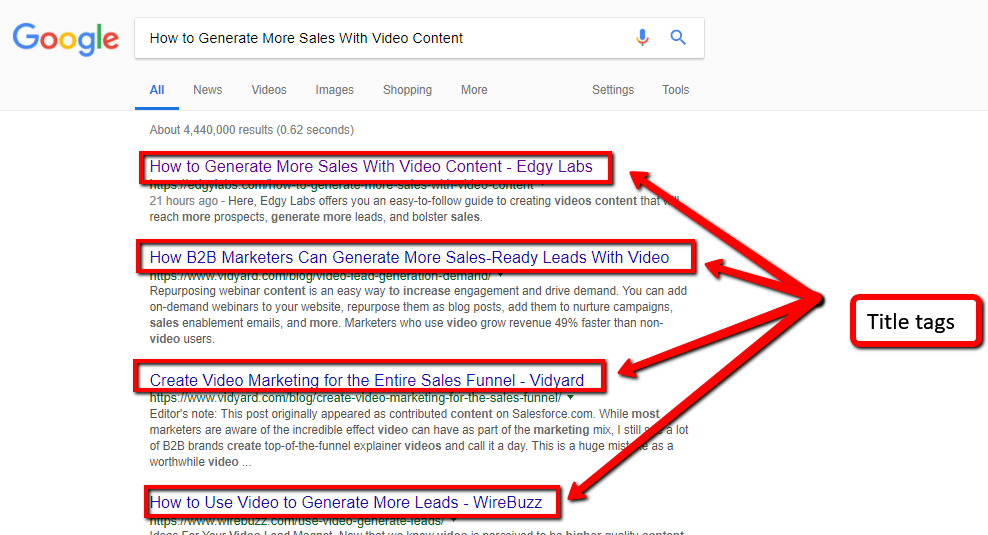Despite the continuous changes in search engine algorithms, web pages with the best SEO title tags are still dominating the SERP.
You probably know by now that ranking in Google takes more than just optimizing one element of your web page. However, we can’t discount the fact that the page title tag is still considered one of the most significant SEO elements of a web page. In fact, web pages with the best SEO title tags are said to rank better in SERP.
But, what is a title tag?
If you’re new to SEO, the title tag is the HTML element that is used to specify the title of a web page. Essentially, it is the name of a web page and typically displayed in the tab at the top of the page you’re viewing.

In Google’s search results page, the title tags of web pages are displayed in a list as shown in the image below.

In raw HTML code, a title tag is written as follows:
<title>How to Generate More Sales With Video Content</title>
The primary purpose of a page title tag is to let readers and search engines know what the web page is all about. It should always make sense to the people searching for your website.
At a glance, you’ll notice that title tags are short and concise, so it is crucial that you create one that will entice people to click-through your post from the SERP or from wherever it is posted.

Aside from giving people and search engines first-hand knowledge about your web page, creating the best SEO title tags are essential in making positive first impressions to potential visitors and in leveraging your brand.
If you’re having troubles creating the best title tags for your web pages, here are some tips that you could follow.
Tips on Creating the Best SEO Title Tags for Your Web Pages
1. Combine Head and Long-Tail Keywords
When it comes to title tags, it is highly recommended that you optimize for one “head” keyword and at least one or two long-tail keywords.
Head keywords are terms with a high search volume that are generally competitive to rank for in search. Because of this, it would take some time to rank for these keywords.
However, while you’re working on it, you may start driving traffic to your web page by adding the long-tail variations of your primary keyword to your title tag.
Long-tail keywords, according to white hat SEO evangelist David McSweeney, “are the search queries with very low individual search volume, but an enormous total search demand as a group. The name comes from the “long tail” of the so-called “search demand curve” — a graph, that plots all keywords by their search volumes.”
Here’s a good example of how you can combine head and long-tail keywords to create the best SEO title tags for your web pages.
- Head Keyword: “SEO tips” (3,800 searches/month)
- Long-tail variation 1: “SEO tips for beginners” (100 searches/month)
- Long-tail variation 2: “small business SEO tips” (70 searches/month)
Keywords still play a vital role in search engine optimization. Thus, it is important that you have a reliable keyword research tool for this task.
Read More: How to Identify Keyword Opportunities for a #1 Ranking on Google
2. Basic Title Tag
Once you have selected your head keyword and long-tail keyword variation, it’s now time to draft your basic title tag.
Remember, there are three rules that you should follow when drafting your title tags:
- Make sure it accurately describes what your page is about.
- Make it short and concise. It should not exceed 50-60 characters. Otherwise, the search engine will truncate it.
- Add your keywords.
Let’s say you want to create a title tag for your tips on finding the best Twitter hashtags.
- Head keyword: Twitter hashtags
- Long-tail variation: best Twitter hashtags for 2018
From the two keywords, your title tag could be: “Finding the Best Twitter Hashtags for 2018.”
3. Showcase What’s Unique About Your Page/Content
Every day, millions of people are using Google and other search engines to perform searches. However, there are certain qualities that people are looking for, depending on the nature of the search.
The best SEO title tags reflect these qualities to attract the attention of potential visitors. Here are some of the title tag qualities that people typically pay attention to when making search engine queries.
- Quantity – One of the newest trends today is list posts. People love them. So, if you are enumerating tips or other things in your content, it is best that you include a number in your title tag.
- Thoroughness – People are particularly drawn to in-depth resources. If you’re able to imply that your page content is more thorough than the other search results in your title tag, people will be enticed to click on it and visit your page. Some terms that you can use to suggest thoroughness are complete, study, and step-by-step.
- Straightforward – People prefer straightforward and concise titles. This gives them a quick glimpse of what your page is all about.
- Freshness – Adding a year or date in your title tag gives it some sense of freshness. Always remember that people prefer fresh and up-to-date content.
- Brand – People will most likely click on title tags associated with a brand. If you own a brand that is well-known in your industry, make the most out of it and include it in your title tag.
Dos and Don’ts When Creating the Best SEO Title Tags According to Google
When creating title tags for your web pages, here are some of the things that you should avoid and do according to Google.
Don’ts
- Avoid choosing a title tag that is not related or has nothing to do with your page content.
- Avoid using default or unclear titles like “New Page 1” or “Untitled.”
- Avoid using a single title tag for different pages in your website.
- Avoid long title tags with overloaded information.
- Avoid keyword stuffing or the use of unnecessary keywords in your title tags.
Dos
- Always use an accurate description of your page in your title tags.
- Always make your title tags unique per page.
Now that you know how to make the best SEO title tags, all you have to do is visit your web pages and see if you can improve your titles.



















Thanks for such great blog information with all new information.
https://goo.gl/9jWik9
……. Many people try to invest their money so as to make more profit after a certain period of time. This is certainly not a wrong move but scammers online make use of this opportunity to deprive people of their money. You might have invested your Bitcoin in the wrong investment company and lost it but you do not need to worry reach out to Mrs Lisa for help in getting your funds recovered. she helped me as well mail her via. ‘ Lisa.Eric at proton.me ‘ or whatsapp + 84 94 767 1524 …..